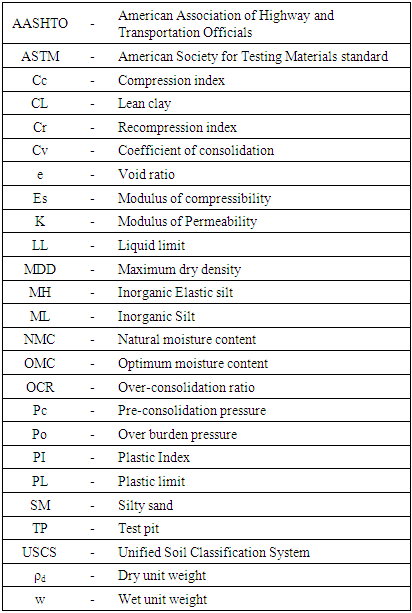-
Paper Information
- Next Paper
- Paper Submission
-
Journal Information
- About This Journal
- Editorial Board
- Current Issue
- Archive
- Author Guidelines
- Contact Us
Journal of Civil Engineering Research
p-ISSN: 2163-2316 e-ISSN: 2163-2340
2020; 10(2): 39-46
doi:10.5923/j.jce.20201002.02
Received: Feb. 27, 2020; Accepted: Apr. 30, 2020; Published: Sep. 26, 2020

Investigation on Engineering Characteristics of Soils. A Case Study in Wolkite University Compound, Ethiopia
Kitata Adugna, Yosef Yirga
Department of Civil Engineering, Wolkite University, Ethiopia
Correspondence to: Kitata Adugna, Department of Civil Engineering, Wolkite University, Ethiopia.
| Email: |  |
Copyright © 2020 The Author(s). Published by Scientific & Academic Publishing.
This work is licensed under the Creative Commons Attribution International License (CC BY).
http://creativecommons.org/licenses/by/4.0/

Investigation of the ground conditions is used for the economical design of the sub- structural elements. It is also necessary to obtained sufficient information on type, characteristics and distributions of a soil and rock underlying at a site of proposed structures for feasibility and economic studies for the proposed project. Thus the purpose of this article was to investigate engineering properties of the soils Wolkite University. To achieve the objective samples from different parts of the compound were collected and laboratory tests were done on the collected samples. The grain size analysis test result showed that the dominant proportion of soil particle in the research area is clay, which have clay content ranging from 5.4 – 40 5%, silt faction 17.6 - 60.7%, sand fraction 14.5 - 54.6% and gravel content from 0.0 – 24.8%. The result of Atterberg Limit test on the soil in the research area showed a liquid limit ranging from 29 – 73%, plastic limit ranging from 21 – 35% and plastic index from 13 – 34%. The specific sravity ranges from 2.40 to 2.70. Free swell test conducted on the samples collected shows range from 18 – 50%. From the compaction test results the maximum dry density (MDD) of wolkite University soil ranges from 1.20 to 1.62 g/cm3 and the optimum moisture content ranges 17.5 to 36.5 percent. According to the Unified Soil Classification System, the soil is categorized as silt and silty sand. Finally one-dimensional consolidation test was done and it shows that the area under investigation is over consolidated in its natural state, have compression index ranging from 0.33-0.40, recompression index ranging from 0.017-0.066, and coefficient of permeability ranging from 10-7 to 10-9 cm/sec.
Keywords: Plastic limit, Atterberg limit, Consolidation, Specific gravity, Ethiopia
Cite this paper: Kitata Adugna, Yosef Yirga, Investigation on Engineering Characteristics of Soils. A Case Study in Wolkite University Compound, Ethiopia, Journal of Civil Engineering Research, Vol. 10 No. 2, 2020, pp. 39-46. doi: 10.5923/j.jce.20201002.02.
Article Outline
1. Introduction
- A geotechnical engineer determines and designs the type of foundation, earthwork, and/or pavement sub-grades required for the intended man-made structures to be built. Foundations are designed and constructed for the structures of various sizes such as high-rise buildings, bridges, medium to large commercial buildings, and smaller structures where the soil conditions do not allow code-based design. Investigation of the underground conditions at a site is prerequisite to the economical design of the substructure elements. It is also necessary to obtain sufficient information for feasibility and economic studies of the proposed project. Public building officials may require soil data together with the recommendations of the geotechnical consultant prior to issuing a building permit, particularly if there is a chance that the project will endanger the public health or safety or degrade the environment. Insufficient geotechnical investigations, faulty interpretation of results, or failure to portray results in a clearly understandable manner may contribute to inappropriate designs; delays in construction schedules, costly construction modifications, and use of substandard borrow material, environmental damage to the site, post construction remedial work, and even failure of a structure and subsequent litigation. Therefore, to obtained information on type, characteristics and distributions of a soil, geotechnical investigations should be done on soil and rock underlying (and sometimes adjacent to) a site of proposed structures In a country like Ethiopia which is developing at high growth rate and which needs many construction works in the future, geotechnical investigation on the engineering property of soil is very essential. Because these data are very important for civil engineers in preliminary design and in designing foundation, pavement, retaining structures, etc for future construction projects in the country. The study was conducted in SNNPR in Gurage zone at Wolkite University which is located about 20 km away from east of Wolkite town and 180 km south of Addis Ababa. The topography of the area is characterized by slopping and rugged areas with very little plain land. However, the engineering property of the soil in the city doesn’t studied. This research was therefore directed to investigating the index property and consolidation characteristic, identifying the characteristics of the soil.
2. Literature Review
- Soil, from geotechnical engineering point of view, is defined as a natural aggregate of mineral grains, with or without organic constituents that can be separated by gentle mechanical means such as agitation in water. By contrast rock is considered to be a natural aggregate of mineral grains connected by strong and permanent cohesive forces. The process of weathering of the rock decreases the cohesive forces binding the mineral grains and leads to the disintegration of bigger masses to smaller and smaller particles.In order to achieve the objectives of this article, literature reviews of many investigators are done. Many researches were done and there were ongoing researches in most big cities of the country like Addis Ababa, Bahir Dar, Mekele, Hawassa, etc. To mention some of the researches undertaken are: ‘Investigation into some of the engineering properties of red clay soils in Bahir Dar (Fasil, A., 2003), ‘Investigation into some of the engineering properties of red clay soils in Addis Ababa’ (Samuel, T., 1989), ‘Investigation into engineering properties of Mekelle soils with emphasis on expansive soils’(Kibrom, G., 2005), etc.
3. Objectives of Study
- General objectives Ø To investigate some the engineering and index properties of the wolkite university soil.Specific ObjectivesØ To investigate some the engineering and index properties of the wolkite university. Ø To determine the range of values of index property of soil in different parts of the university. Ø To determine the consolidation characteristic of soils in the university.
4. Methodology
- In order to achieve the objectives of this thesis, literature reviews of many investigators are done. Necessary information about the geology, climatic condition and topography of the site are collected and analyzed. Reconnaissance study of the area is done by visiting the entire part of the university. The location of test pits is selected so that it can well represent the soil types (visually) found in the university. Roughly it includes red clay, gray and the black cotton soils, which are the main soil types found in the study area.Once the locations of the test pits are selected, the excavation work is conducted by daily laborers using local digging equipment. This excavation is continued up to 1.5m and 2.5m depth then disturbed samples are taken by plastic bags. Undisturbed samples are taken from both depths. After the undisturbed samples are extracted both ends of steel tube. Both the disturbed and undisturbed samples transported to the wolkite University Geotechnical laboratory.Undisturbed samples are used for one dimensional consolidation, natural moisture content and unit weight tests. Disturbed samples are used to conduct index property tests such as specific gravity, Atterberg limit, grain size analysis, compaction and free swell. ASTM procedures are followed for all tests.Using Microsoft Office Excel, grain size distribution curve, liquid limit graph, compaction curve, consolidation and unconfined compression tests are plotted.
5. Analysis
- Ø The water content is the ratio, expressed as a percentage, of the mass of “pore” or “free” water in a given mass of soil to the mass of the dry soil solids. ASTM D 2216.
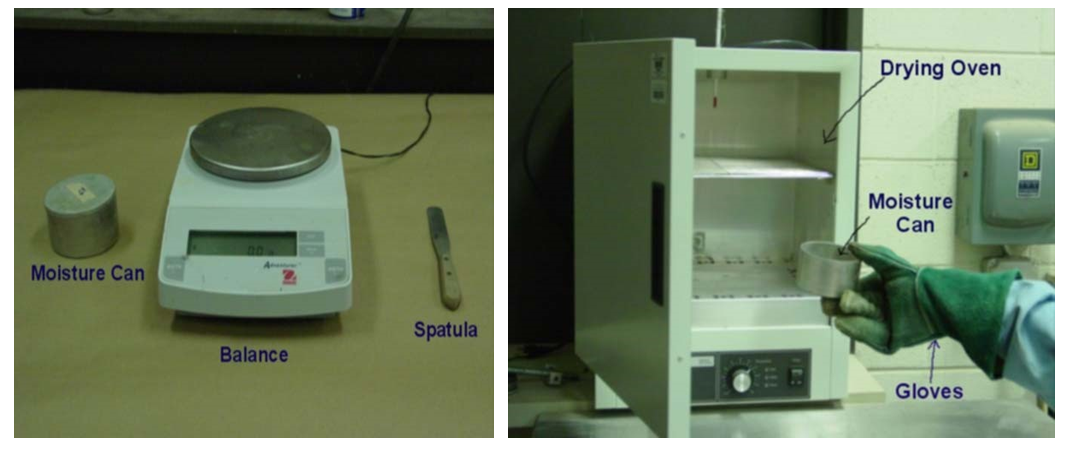 | Figure 1. Water content test |
 | Figure 2. Specific gravity test |
 | Figure 3. Sieve analysis |
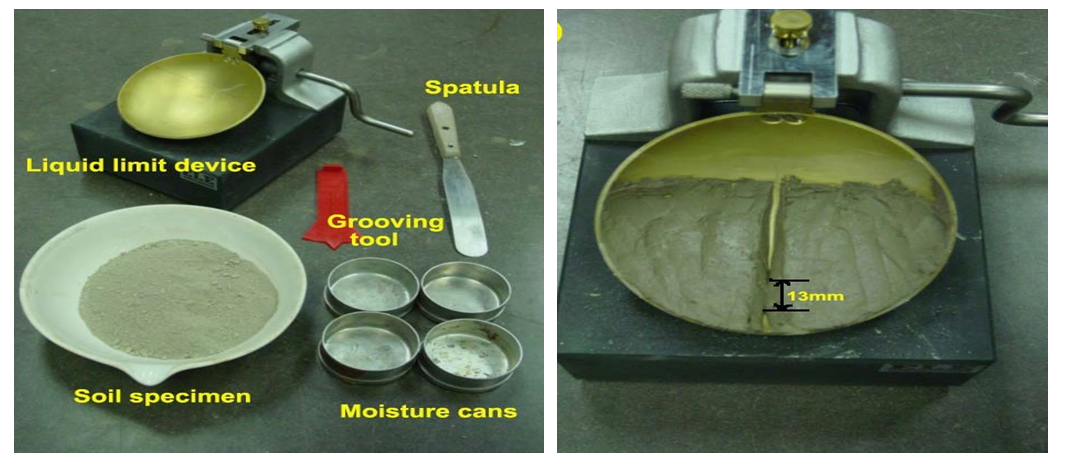 | Figure 4. Plastic limit test |
 | Figure 5 |
 | Figure 6. Consolidation test |
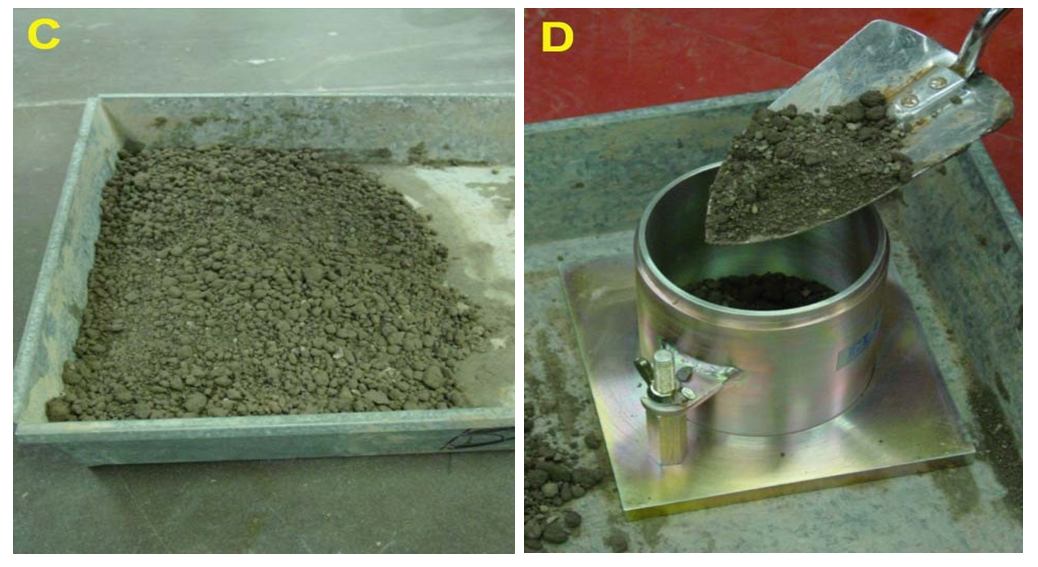 | Figure 7. Compaction test |
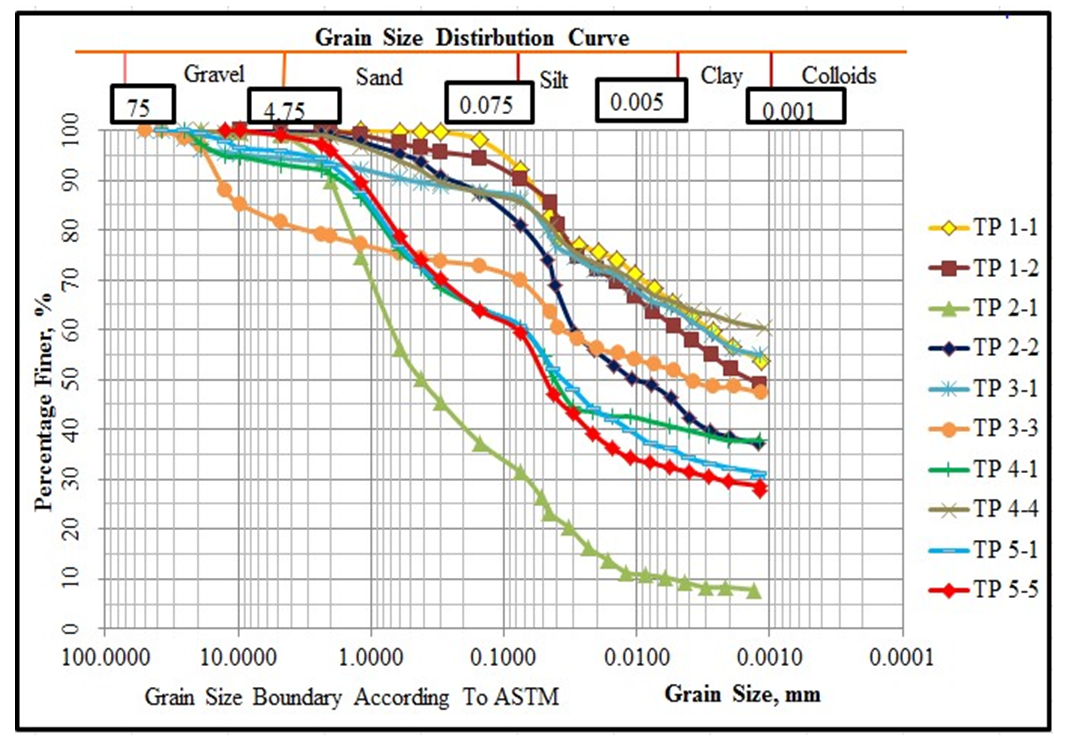 | Graph 1. Grain size distribution curve for samples from test pits 1 to 5 |
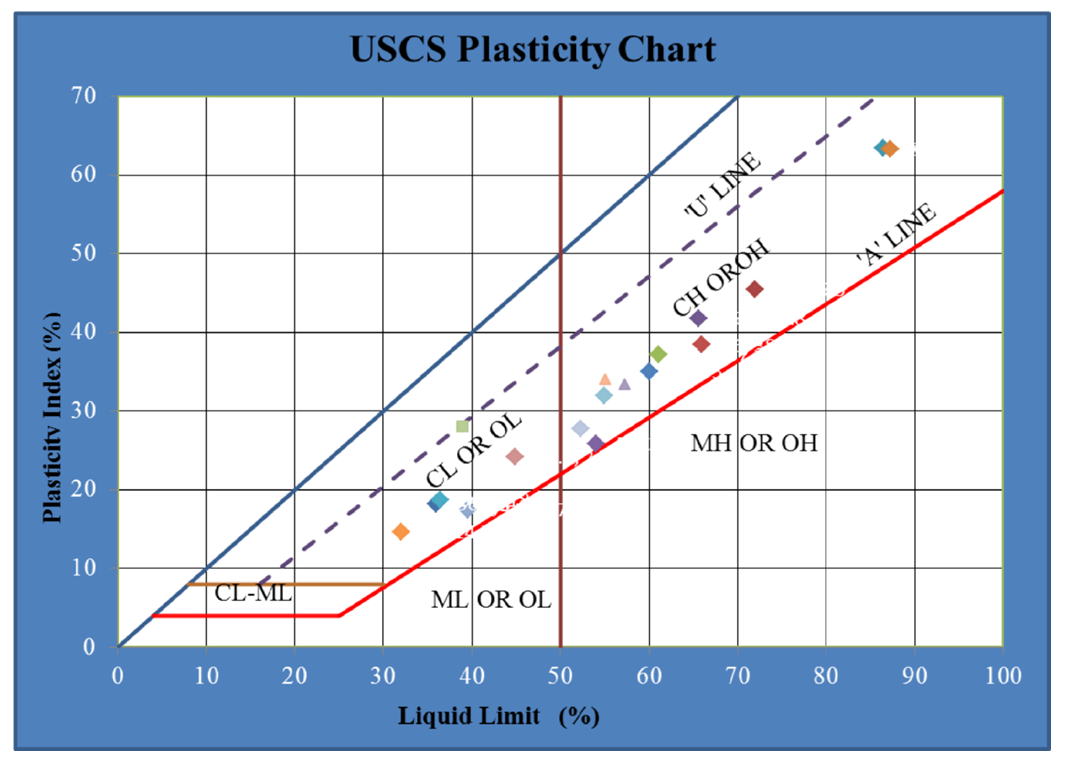 | Graph 2. Plasticity chart of the study area according to Unified Soil Classification System |
6. Results
- The results of specific gravity test indicate that the specific gravity of soils of the study area, which is in the range of typical specific gravity values of inorganic soils. The test results of Atterberg’s limits indicate that some of soils of the study area are highly plastic soil with high plasticity index values. However soils from TP2 at 1.5m are non-plastic material. The results obtained from the Grain Size Analyses indicate that the dominant proportion of soil particle in the study area is clay and sand. The free swell test results of soils of study area are mostly in between 50% and 100% except soils from TP-3 at 1.5m, 3m depth which are typically expansive soil. Most of the soils have moderate expansive nature, which have a little impact on construction of structures. From the test results the maximum dry density (MDD) of Wolkite University from 1.39 to1.52 g/cm3 and the optimum moisture content ranges 13 to 23.4 percent. Plasticity chart of the study area according to Unified Soil Classification System shows that the soil under investigation lies above the A-line in the region of inorganic clay. That means inorganic clay with high plastic (CH) and Low to medium plastic (CL). Classifications of soils in the study area based on AASHTO Classification system is shown in the study area according to AASHTO system of classification. From this table and chart it can be observed that soil in the study area is classified in group A-2-4, A-6, and A-7-6. AASHTO classification shows that most of the soil of the study area falls in A-6 and A-7-6 groups except samples from TP-2 at 1.5m at 3m which is silty or clayey gravel and sand. A-6 and A-7-6 materials are generally considered the poorest performers with regard to roadway construction, but can be utilized in sub-grade material. Further, more group index values of the samples is calculated and indicate that 50% of the samples are below 20, which are good source of sub-grade material, other samples may need some stabilization techniques to use as source of material. The value of GI is greater than 20 for the rest of 50% samples this indicates that percentage amount of fine particles (#200) is high; this indicates the soils are highly plastic nature. Classification of soil in the study area based on activity chart observed that soil of study area ranges from in active to active soil. The plot of vertical pressure versus void ratio on semi-log and linear scale. Except their variation in initial void ratio the plot shows similar curvature for all the samples. The soil has a pre-consolidation pressure of 90-150kPa. Over-consolidation ratios of the soils are more than one, so the soil in the study area is over consolidated in its natural state. The coefficient of consolidation Cv, which was calculated from curve of compression dial reading versus logarithm-of-time fitting method for each incremental loading is plotted as a function of effective stress. From this it can be observed that, the shapes of the curves for three samples are almost similar and the same is true for value of coefficient of consolidation for each incremental loading. It was observed that the Cv value increased with increasing void ratio. The samples also broadly showed a decrease of coefficient of consolidation with increasing effective pressure. The compression index, Cc of the soil is calculated from the slope of the straight portion of the void ratio versus log pressure plot. This calculation shows that the compression index, Cc, ranges from 0.13-0.33.
7. Conclusions
- Based on the test results obtained the following conclusions were drawn: • From visual observations and field tests, the soils of the area are classified as clay with high plasticity. According to Textural Classification System the soils studied are classified as silty-clay to clay. And from indices classification criteria these soils can be labelled as clay with high plastic and firm consistency.According to the Unified Soil Classification System (USCS) and AASHTO the soils are classified as CH (clay with high plasticity) and G-7-5 (clayey soils) respectively.• Mechanical grain size analysis shows that more than 90% of the total masses pass through sieve size of 75μm. This indicates that almost all soils can be taken as fine-grained soils. From hydrometer analysis, for most of the samples, more than 50% of their grain sizes are less than 50μm (clay size range as per ASTM boundaries criteria). This suggests that these types of soils are highly influenced by the presence of clay content.• The specific gravity of the studied soils ranges between 2.58 to 2.82. This indicates that the soils are inorganic and for the lateritic soils investigated, their specific gravity is higher. This is due to the presence of significant amount of iron-oxide in the mineral content of the lateritic soils.• Atterberg limit and swelling pressure tests showed that Soils from sample TP-2, TP-4, TP-5 were found to be expansive. The degree of expansiveness varies from medium to very high. Their percentage of free swell extends from 80% to 130% which would have an adverse effect on light weight ordinary structures.• The ratio of pre-consolidation pressure with respect to overburden pressure shows the soils are over-consolidated with OCR greater than 2. The pre-consolidation pressure of the soils ranges from 210 to 300 KPa. This indicates the soil of the study area is over consolidated residual soil. The compression and swelling indices of these soils varies from 0.238 to 0.399 and 0.0393 to 0.0947 respectively. The characteristic coefficient of consolidation extends from 1.15x10-1 to 7.47x10-3 cm2/min.• From the evaluation of existing empirical formulas, some correlations agree with minor deviation from laboratory test results while for most of the correlations their values deviate significantly from the laboratory test results for soils of the study area. Hence, it can be concluded that before the adoption of these correlations proper verifications are required to taste their applicability for local soils.
8. Recommendations
- § Further detailed investigation has to be carried out on a number of additional disturbed and undisturbed samples from different locations of the university and Gubre town to prepare a reliable geotechnical map of Wolkite University.§ The engineering properties of soils have to be studied in detail. § For a complete presentation of the engineering properties of the soil in the university dynamic properties of the soils should also be studied.
 Abstract
Abstract Reference
Reference Full-Text PDF
Full-Text PDF Full-text HTML
Full-text HTML